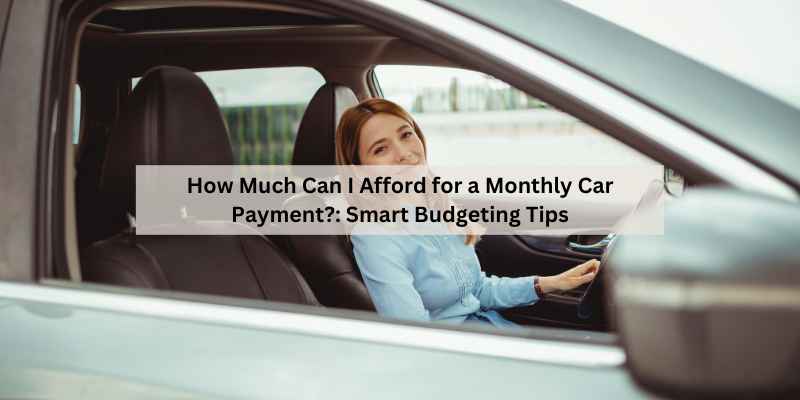How Much Can I Afford for a Monthly Car Payment?: Smart Budgeting Tips
To determine how much you can afford for a monthly car payment, calculate 15% of your monthly take-home pay. This ensures that your budget remains manageable without stretching your finances.
Buying a car is a significant financial commitment. Understanding how much you can afford for a monthly car payment is crucial for maintaining financial stability. Many factors influence this decision, including your income, expenses, and overall financial goals. Experts recommend allocating no more than 15% of your take-home pay to car payments.
This guideline helps you avoid straining your budget while still enjoying the benefits of a reliable vehicle. Before making a decision, consider additional costs like insurance, maintenance, and fuel. A well-rounded approach to budgeting will ensure you make a smart purchase that aligns with your financial situation.
Assessing Your Financial Landscape
Understanding your income is the first step. List your monthly earnings from all sources. Include salary, bonuses, and any side jobs. This total helps you see what you can spend.
Next, take a close look at your current expenses. Write down all fixed costs. These include rent, utilities, and groceries. Don’t forget variable costs like entertainment and dining out. This gives a clear picture of your spending habits.
| Expense Type | Estimated Monthly Cost |
|---|---|
| Rent/Mortgage | $1,200 |
| Utilities | $150 |
| Groceries | $300 |
| Transportation | $200 |
| Entertainment | $100 |
The 20/4/10 Rule Of Car Buying
The 20/4/10 rule helps buyers make smart car choices. Save 20% for a down payment. Choose a loan term of four years or less. Monthly payments should be no more than 10% of your income.
For down payment guidelines, aim for at least 20% of the car’s price. This reduces your loan amount. A larger down payment means lower monthly payments.
Loan term recommendations suggest keeping it under 48 months. Shorter loans usually have lower interest rates. This saves money in the long run.
Managing insurance and maintenance costs is crucial. Keep insurance under 10% of your monthly budget. Set aside funds for regular maintenance and unexpected repairs.
Calculating Your Affordability
Understanding the total car cost is essential for budgeting. Monthly payments depend on the car’s price, taxes, and fees. Consider your down payment; a larger amount lowers monthly costs.
Interest rates significantly affect your overall payment. Higher rates mean more money paid over time. Always shop around for the best rates. This can save you money each month.
Loan calculators help you estimate payments easily. Input the total cost, down payment, and interest rate. This gives you a clear picture of your monthly payment. Many online tools simplify this process.
Factors Affecting Your Monthly Payment
Credit score plays a big role in monthly car payments. A higher score often means lower interest rates. It can save you money over time. Check your credit score before shopping for a car.
Choosing between leasing and buying affects payment amounts. Leasing usually offers lower monthly payments. Buying builds equity in the car. Consider your budget and needs before deciding.
| Option | Monthly Payment | Ownership |
|---|---|---|
| Leasing | Lower | No ownership |
| Buying | Higher | Full ownership |
Setting A Realistic Car Budget
Creating a car budget starts by prioritizing your needs over your wants. Focus on essential features. Think about safety and reliability first. Avoid flashy extras that can drive up costs.
Consider your future financial goals. Saving for a home or education is important. A car should not hinder your ability to reach these goals. Set a monthly payment limit that aligns with your budget.
- Assess your monthly income.
- Calculate your living expenses.
- Determine how much you can afford for a car payment.
Stay within your budget. This ensures a stress-free car ownership experience.
How To Reduce Your Monthly Payment
Negotiating your monthly payment can save you money. Start by researching the car’s value. Know the market prices before entering discussions. Always ask for discounts or special offers.
For trade-ins, ensure your old car’s value is accurately assessed. Clean your car and gather all documents. Present it well to attract a better trade-in offer.
Explore different financing options. Compare interest rates from banks and credit unions. A lower rate can greatly reduce your monthly payment. Consider a longer loan term for smaller payments, but be cautious of total interest paid.
Dealing With Unexpected Costs
Unexpected costs can arise when owning a car. Regular maintenance is essential to keep it running well. This includes oil changes, tire rotations, and brake checks. Neglecting these can lead to expensive repairs later.
Repairs can also come unexpectedly. A flat tire or engine issue can happen at any time. It’s wise to set aside money each month for these costs. Planning helps avoid financial stress during emergencies.
Fuel economy plays a big role in monthly expenses. A car with good fuel efficiency saves money. Check the miles per gallon (MPG) before buying a car. This can help determine overall costs.
| Car Type | Average MPG |
|---|---|
| Sedan | 25-35 |
| SUV | 20-28 |
| Truck | 15-25 |
Staying Financially Safe With Your Car Purchase
Setting aside emergency funds is crucial for financial safety. These funds help cover unexpected costs. Aim for at least three to six months of living expenses. This way, you can manage any sudden repairs or bills without stress.
Negative equity occurs when your car’s value drops below what you owe. To avoid this, choose a vehicle that holds its value. Consider purchasing a used car instead of a new one. This strategy helps in reducing depreciation costs. Always aim for a down payment of at least 20%. It reduces the loan amount and lowers the chances of negative equity.
Frequently Asked Questions
How Can I Calculate My Budget For A Car Payment?
Start by determining your monthly income and expenses. Use the 20/4/10 rule: aim for a 20% down payment, finance for no more than four years, and keep payments under 10% of your monthly income. This ensures a manageable and sustainable car payment.
What Factors Affect My Car Payment Affordability?
Key factors include your income, existing debts, credit score, and down payment. A higher credit score can lead to lower interest rates. Additionally, consider insurance, maintenance, and fuel costs. These elements collectively influence how much you can comfortably afford monthly.
How Much Should I Spend On A Car?
Experts recommend spending no more than 15% of your annual income on a car. This includes both the purchase price and additional costs like taxes and fees. Stick to this guideline to ensure you maintain financial health while enjoying your vehicle.
What Is The Average Monthly Car Payment?
As of recent data, the average monthly car payment is around $500. However, this varies based on vehicle type, financing terms, and buyer credit scores. Always compare different financing options to find a payment that fits your budget.
Conclusion
Determining your budget for a monthly car payment is essential. Assess your income, expenses, and savings to find a comfortable range. Consider all costs, including insurance and maintenance. By setting a realistic budget, you can enjoy your vehicle without financial stress.
Make informed choices for a brighter financial future.






